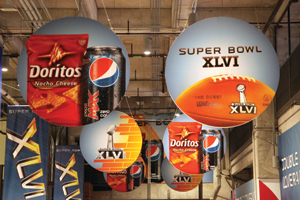A client asked recently how to avoid the pitfalls surrounding marketing campaigns that are built to support sports, entertainment and event properties. As sponsorships come under greater scrutiny, this is an important question, particularly with companies seeking growth and value from existing and potential partnerships and more benefits given the current economic environment.
The keys to success lie in bringing a marketer’s sponsorship to life in real and meaningful ways. A vital element of the sponsorship decision is determining what success looks like at the outset of a campaign. One of the biggest reasons that sponsorships fail is that key constituencies have a different view of desired results and don’t have a clear understanding of what success looks like before committing money and resources needed to support a sponsorship investment.
Also critical to success is applying creative resources necessary to ensure that a company can use the sponsorship as a marketing and communications platform on which to build.
Perhaps nobody does this better than Nike. No matter what sport, event or athlete the company is promoting, it’s very clear that the brand is first and foremost about performance, and everything else emanates from there.
■ Plan for success; avoid failure
Even with the sophistication of today’s metrics and measurement tools, there are no guaranteed formulas to ensure success. It’s important for each sponsor to create its own methods and criteria in placing a value on its sponsorship investment and determining the ultimate success or failure of a given campaign.
With its “Thank You, Mom” campaign, Procter & Gamble created and implemented a program worthy of Olympic gold. Not only did the commercials tug at our heartstrings and connect the company’s products to its target customers, but P&G also activated its sponsorship by helping to offset travel costs to London for more than 800 mothers of Olympic and Paralympic athletes. Through this effort, the company is expecting to generate $500 million in additional sales.
 |
Pepsi’s presence at Super Bowl XLVI was felt far beyond its ads during the game broadcast.
Photo by: NFL |
First, establish a potential revenue base that would come from the sale of products and services to existing and prospective customers. Set specific, measurable goals and objectives that will automatically define the category or area that is most beneficial to your needs and, therefore, the approximate cost. Then, commit to promotional spending that is at least equivalent to the cost of the sponsorship, taking into consideration that the most successful programs are based on ratios that are two or three times as much as the sponsorship fee itself.
One of the most common problems I see is spending the majority of marketing dollars on the sponsorship with little or nothing left to advertise, promote and publicize a company’s involvement.
In some cases, keeping the competition out of a particular field of interest, whether it’s a league, team, sport or event, may be the deciding factor in choosing a particular opportunity.
Finally, in putting a value on a sponsorship, a company should consider the cost savings of not being a sponsor. The rise of ambush marketing, cluttered sponsorship fields, lack of exclusivity and confusion as to which companies are official sponsors are the most common reasons to just say no. A recent example is GM deciding it couldn’t justify the cost to advertise on the 2013 Super Bowl. Reports are that CBS is charging a record $3.7 million to $3.8 million for 30-second slots.
■ Activate, integrate or die trying
In developing strategic and creative sponsorship campaigns, consider all elements in the marketing tool box. More often than not, public relations, product seeding and social media set the stage for advertising, sales, events, promotions and hospitality that drive the sponsorship message home.
I’m not sure there’s a better example of this than Coca-Cola, which basically wrote the book on sponsorship activation. Whether it’s the Olympics, World Cup, NASCAR or “American Idol,” Coca-Cola makes sure that integrated marketing is an essential part of planning, executing and measuring the success of its supporting campaigns.
Strategic corporate and media partnerships with like-minded companies can broaden reach and frequency. Marketing, both online and off, generates leads and reaches consumers in unconventional ways. For consumer goods companies, product seeding, publicity and integration are vital to ensure that products “show up” in the right places in the right way. Many sponsors provide consumers with unique moments through experiential marketing, events and promotions. And, of course, media outreach is essential in securing positive news coverage, testimonials and third-party credibility.
I appeared earlier this year on a local TV morning show to critique the best and worst of Super Bowl ads. Creativity aside, the one thing that struck me was how some companies activated around the Super Bowl and others did not. Pepsi Max, Ritz Crackers and Pizza Hut all succeeded from an engagement perspective while other advertisers missed the mark completely by focusing solely on the ad itself. If you’re spending $3 million for a 30-second spot, it’s essential to view it as you would any other kind of sponsorship investment and activate around it.
Today, the relationship between sports and entertainment is inseparable and interchangeable. Sports still make sense as a way to enhance corporate image and increase product visibility despite the inherent risks. It also provides any number of customer entertainment and hospitality opportunities and brand marketing extensions. If done well, sports and entertainment provides companies with advertising, sales and marketing, promotion, public relations, interactive and internal communications value all in one package.
David Nobs (dnobs@lavidge.com) is head of sports marketing for The Lavidge Co., a Phoenix-based advertising, marketing and public relations agency.





